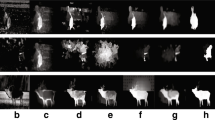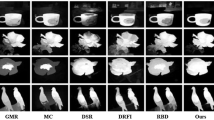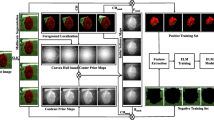Abstract
Salient object detection is a challenging research area, which aims to highlight significant region of the visual scene more accurately and quickly. In this research direction, we propose a novel saliency detection model called Convex Hull Based Random Walks (CoBRa) approach. In the proposed model, an image is segmented into superpixels and Convex Hull is constructed based on the segmented image to roughly partition the segmented image into two regions: CH-foreground and CH-background regions and the centroid of the CH-foreground region is calculated. Then, initial saliency is computed by using two priors viz. contrast and center priors. Here, the proposed model exploits CH-foreground region centroid obtained by Convex Hull to computed center prior which is more efficient than image center. Afterwards, two thresholds are empirically obtained and applied on initial saliency map to produce two binary segmented images. Based on these two binary images, the proposed model collects foreground and background seeds. These seeds are further refined with CH-foreground and CH-background regions to produce reliable and effective seeds. Finally, a random walk is constructed with the determined seeds to generate a pixel-wise saliency map. The superiority of the proposed model is validated via extensive experimental results performed on six publicly available datasets viz. MSRA10K, DUT-OMRON, ECSSD, PASCAL-S, SED2, and THUR15K. The performance of the proposed model was compared with eight state-of-the-art methods in terms of Precision, Recall, F-Measure, Receiver Operating Characteristics (ROC), and Area under the curve (AUC). The proposed method outperforms or comparable with compared methods in terms of all the performance measures.











Similar content being viewed by others
References
Achanta R, Estrada F, Wils P, Süsstrunk S (2008) Salient region detection and segmentation. In: International conference on computer vision systems, Springer, pp 66–75
Achanta R, Hemami S, Estrada F, Süsstrunk S. (2009) Frequency-tuned salient region detection. In: IEEE International conference on computer vision and pattern recognition (CVPR 2009), CONF, pp 1597–1604
Achanta R, Shaji A, Smith K, Lucchi A, Fua P, Süsstrunk S (2010) Slic superpixels. Tech rep
Alpert S, Galun M, Basri R, Brandt A (2007) Image segmentation by probabilistic bottom-up aggregation and cue integration. In: Computer vision and pattern recognition, 2007. CVPR ’07. IEEE Conference on, IEEE, pp 1–8
Borji A, Cheng MM, Jiang H, Li J (2015) Salient object detection: a benchmark. IEEE Trans Image Process 12(24):5706–5722
Chen T, Lin L, Liu L, Luo X, Li X (2016) Disc: Deep image saliency computing via progressive representation learning. IEEE Trans Neural Netw Learn Syst 27(6):1135–1149
Cheng MM, Mitra NJ, Huang SX, Torr PH, Hu SM (2015) Global contrast based salient region detection. IEEE Trans Pattern Anal Mach Intell 37 (3):569–582
Cheng MM, Mitra NJ, Huang X, Hu SM (2014) Salientshape: group saliency in image collections. Vis Comput 30(4):443–453
Deng C, Yang X, Nie F, Tao D (2020) Saliency detection via a multiple self-weighted graph-based manifold ranking. IEEE Trans Multimed 22 (4):885–896
Duan L, Wu C, Miao J, Qing L, Fu Y (2011) Visual saliency detection by spatially weighted dissimilarity. In: 2011 IEEE conference on computer vision and pattern recognition (CVPR), IEEE, pp 473–480
Everingham M, Van Gool L, Williams CK, Winn J, Zisserman A (2010) The pascal visual object classes (voc) challenge. Int J Comput Vis 88 (2):303–338
Frintrop S, Backer G, Rome E (2005) Goal-directed search with a top-down modulated computational attention system. In: Joint pattern recognition symposium, Springer, pp 117–124
GOFERMAN S (2010) Context-aware saliency detection. In: Proc IEEE Conf Computer vision and pattern recognition, 2010, pp 2376–2383
Grady L (2006) Random walks for image segmentation. IEEE Trans Pattern Anal Mach Intell 28(11):1768–1783
Guo F, Wang W, Shen J, Shao L, Yang J, Tao D, Tang YY (2017) Video saliency detection using object proposals. IEEE Trans Cybern 48 (11):3159–3170
Guo F, Wang W, Shen Z, Shena J, Shao L, Tao D (2020) Motion-aware rapid video saliency detection. IEEE Trans Circuits Syst Video Technol 30(12):4887–4898
Harel J, Koch C, Perona P (2007) Graph-based visual saliency. In: Advances in neural information processing systems, pp 545–552
Hou X, Zhang L (2007) Saliency detection: A spectral residual approach. In: Computer vision and pattern recognition, 2007. CVPR’07. IEEE conference on, IEEE, pp 1–8
Itti L, Koch C, Niebur E (1998) A model of saliency-based visual attention for rapid scene analysis. IEEE Trans Pattern Anal Mach Intell 20(11):1254–1259
Jian M, Zhao R, Sun X, Luo H, Zhang W, Zhang H, Dong J, Yin Y, Lam KM (2018) Saliency detection based on background seeds by object proposals and extended random walk. J Vis Commun Image Represent 57:202–211
Kim JS, Kim JH, Kim CS (2009) Adaptive image and video retargeting technique based on fourier analysis. In: 2009 IEEE conference on computer vision and pattern recognition, IEEE, pp 1730–1737
Kim JS, Sim JY, Kim CS (2014) Multiscale saliency detection using random walk with restart. IEEE Trans Circuits Syst Vid Technol 24(2):198–210
Ko BC, Nam JY (2006) Object-of-interest image segmentation based on human attention and semantic region clustering. JOSA A 23(10):2462–2470
Lee G, Tai YW, Kim J (2017) Eld-net: an efficient deep learning architecture for accurate saliency detection. IEEE Trans Pattern Anal Mach Intell 40 (7):1599–1610
Li C, Yuan Y, Cai W, Xia Y, Dagan Feng D (2015) Robust saliency detection via regularized random walks ranking. In: Proceedings of the IEEE conference on computer vision and pattern recognition, pp 2710–2717
Li J, Levine MD, An X, Xu X, He H (2013) Visual saliency based on scale-space analysis in the frequency domain. IEEE Trans Pattern Anal Mach Intell 35(4):996–1010. https://doi.org/10.1109/TPAMI.2012.147
Li Y, Hou X, Koch C, Rehg JM, Yuille AL (2014) The secrets of salient object segmentation. In: Proceedings of the IEEE conference on computer vision and pattern recognition, pp 280–287
Lin X, Wang ZJ, Tan X, Fang ME, Xiong NN, Ma L (2019) Mcch: A novel convex hull prior based solution for saliency detection. Inf Sci 485:521–539
Liu T, Yuan Z, Sun J, Wang J, Zheng N, Tang X, Shum H (2011) Learning to detect a salient object. IEEE Trans Pattern Anal Mach Intell 33(2):353
Liu Y, Han J, Zhang Q, Wang L (2019) Salient object detection via two-stage graphs. IEEE Trans Circuits Syst Video Technol 29(4):1023–1037
Lu X, Wang W, Ma C, Shen J, Shao L, Porikli F (2019) See more, know more: Unsupervised video object segmentation with co-attention siamese networks. In: Proceedings of the IEEE/CVF conference on computer vision and pattern recognition, pp 3623–3632
Ma YF, Hua XS, Lu L, Zhang HJ (2005) A generic framework of user attention model and its application in video summarization. IEEE Trans Multimed 7(5):907–919
Mingming C, Guoxin Z, Mitra NJ, Xiaolei H, Shi-Min H (2011) Global contrast based salient region detection. In: IEEE Conference on computer vision and pattern recognition, Colorado Springs, USA: IEEE computer society press, pp 409–416
Murray N, Vanrell M, Otazu X, Parraga CA (2011) Saliency estimation using a non-parametric low-level vision model. In: 2011 ieee conference on computer vision and pattern recognition (cvpr), IEEE, pp 433–440
Rutishauser U, Walther D, Koch C, Perona P (2004) Is bottom-up attention useful for object recognition?. In: Proceedings of the 2004 IEEE computer society conference on computer vision and pattern recognition, 2004. CVPR 2004, vol 2, IEEE, pp II–II
Seo HJ, Milanfar P (2009) Static and space-time visual saliency detection by self-resemblance. J Vis 9(12):15–15
Singh N, Arya R, Agrawal R (2016) A convex hull approach in conjunction with gaussian mixture model for salient object detection. Digital Signal Process 55:22–31
Wang L, Jiang B, Tu Z, Hussain A, Tang J (2019) Robust pixelwise saliency detection via progressive graph rankings. Neurocomputing 329:433–446
Wang L, Wang L, Lu H, Zhang P, Ruan X (2018) Salient object detection with recurrent fully convolutional networks. IEEE Trans Pattern Anal Mach Intell 41(7):1734–1746
Wang W, Lu X, Shen J, Crandall DJ, Shao L (2019) Zero-shot video object segmentation via attentive graph neural networks. In: Proceedings of the IEEE/CVF international conference on computer vision, pp 9236–9245
Wang W, Shen J, Dong X, Borji A, Yang R (2019) Inferring salient objects from human fixations. IEEE Trans Pattern Anal Mach Intell 42 (8):1913–1927
Wang W, Shen J, Porikli F (2015) Saliency-aware geodesic video object segmentation. In: Proceedings of the IEEE conference on computer vision and pattern recognition, pp 3395–3402
Xiao Y, Jiang B, Zheng A, Zhou A, Hussain A, Tang J (2019) Saliency detection via multi-view graph based saliency optimization. Neurocomputing 351:156–166
XIE Y, LU H, YANG MH (2013) Bayesian saliency via low and mid level cues. IEEE Trans Image Process 22(5-6):1689–1698
Yan Q, Xu L, Shi J, Jia J (2013) Hierarchical saliency detection. In: Proceedings of the IEEE conference on computer vision and pattern recognition, pp 1155–1162
Yang C, Zhang L, Lu H (2013) Graph-regularized saliency detection with convex-hull-based center prior. IEEE Signal Process Lett 20(7):637–640
Yang C, Zhang L, Lu H, Ruan X, Yang MH (2013) Saliency detection via graph-based manifold ranking. In: Proceedings of the IEEE conference on computer vision and pattern recognition, pp 3166–3173
Yuchen Y, Changyang L, Jinman K, Weidong C, Feng D (2018) Reversion correction and regularized random walk ranking for saliency detection. IEEE Transactions on Image Processing: A Publication of the IEEE Signal Processing Society 27(3):1311
Zhang J, Sclaroff S (2016) Exploiting surroundedness for saliency detection: A boolean map approach. IEEE Trans Pattern Anal Mach Intell 38(5):889–902
Zhang L, Tong MH, Marks TK, Shan H, Cottrell GW (2008) Sun: A bayesian framework for saliency using natural statistics. J Vis 8(7):32–32
Acknowledgements
We acknowledge Ministry of Human Resource Development Government of India, India for supporting this research by providing fellowship to one of the author Mr. Vivek Kumar Singh.
Author information
Authors and Affiliations
Corresponding author
Ethics declarations
Conflict of Interests
All the authors declare that they have no conflict of interest.
Additional information
Publisher’s note
Springer Nature remains neutral with regard to jurisdictional claims in published maps and institutional affiliations.
Rights and permissions
About this article
Cite this article
Singh, V.K., Kumar, N. CoBRa: convex hull based random walks for salient object detection. Multimed Tools Appl 81, 30283–30303 (2022). https://doi.org/10.1007/s11042-022-12470-6
Received:
Revised:
Accepted:
Published:
Issue Date:
DOI: https://doi.org/10.1007/s11042-022-12470-6




